人教版运城市2020年九年级英语Unit 5学案(带答案)
人教版九年级全册英语Unit5 SectionB 知识讲解+专题练习学案(含答案)

Unit5 SectionB一、单项选择1.— Can I pay with my phone?— Sure. Just show me ________ WeChat code and I’ll scan it.A.my B.your C.its D.our 2.—What do you think of science?—I find ________ hard to understand.A.that B.this C.its D.it3.─Why does the earth look blue in space?─Because most of the earth's surface __________ by the ocean.A.covers B.is covered C.cover D.are covered 4.The computer has influenced people's life since it __________.A.invents B.invented C.is invented D.was invented 5.—How do you like Mary?—Oh, she is a________girl and popular with everyone in our class.A.serious B.lively C.strange D.silly二、完型填空Hukou Waterfall: Water Falls from the SkyHukou Waterfall is the largest yellow waterfall in the world. It is also the second waterfall in China next to Huangguoshu Waterfall in Guizhou Province.From its headwater in Qinghai Province, the Yellow River 6 all the way to the east and finally to the sea. It carries Chinese history and civilization(文明) of more than 5,000 years, so the Yellow River is 7 as China's “Mother River”.As it flows to Hukou Village, the river sharply narrows from 500 meters 8 to only about 30 meters. The calm water suddenly falls down into a deep pool 9 thousands of wild horses run forward wildly. As a result, a wonderful waterfall 10 . It seems that the water pours down from a big teapot, so the waterfall has the name Hukou--meaning the 11 of teapot in Chinese.The falling water brings huge smoke and clouds, with color 12 from yellow to grey, grey to blue. People 13 this heart-shaking sight “ smoke from the river”. There isalso a stone under the waterfall. It moves up and down 14 the falling water. It is not seen all the time as the water is always changing, so it is 15 guishi, meaning the “mysterious stone’’.Over history, lots of poets and painters once traveled her. They admired the 16 view, and left numerous works about the great waterfall. 17 them. Li Bai's invitation to wine(《将进酒》maybe the best- known. It says,“Do not you see the Yellow River come from the sky, 18 the sea and never come back?”There are many wonders at Hukou Waterfall, 19 smoke from the river, boats on land and rainbows in the sunshine. April and October are the best time to 20 Hukou Waterfall. Why? Because the water is full!6.A.circles B.runs C.opens D.drives 7.A.described B.increased C.mixed D.developed 8.A.long B.high C.wide D.low 9.A.so far B.so that C.as if D.as soon as 10.A.drops B.goes C.enters D.appears 11.A.mouth B.shape C.bottom D.cover 12.A.facing B.turning C.dividing D.shaking 13.A.think B.seem C.lean D.call 14.A.from B.for C.with D.of 15.A.named B.brought C.caught D.dressed 16.A.lovely B.impossible C.awful D.wonderful 17.A.Between B.Opposite C.Among D.Across 18.A.moving on B.rushing into C.waving to D.dancing to 19.A.thanks to B.according to C.rather than D.such as 20.A.swim B.visit C.drink D.pass三、阅读单选When is the best time for us to enjoy the bright moon? Of course, it is Mid-Autumn Festival, one of the most important holidays in China. We look at the moon, eat mooncakes, and get together with our families. The tradition is thousands of years old.The moon, the key part of the festival, is special to most Chinese people. We enjoy and admire it. We use the round and crescent moon (新月) to describe reunion and separation.Our admiration of the moon dates back to ancient times. There is the legend of Chang’eflying to the moon-the most famous story about the moon. Many Chinese poets connect the moon with homesickness (乡愁). For example, “Beside my bed pool of light. Is it hoarfrost (霜) on the ground?” from Jing Ye Si (Thoughts in the Silent Night) by Tang Dynasty poet Li Bai.Today, the moon is still important to Chinese people. The Miao minority (少数民族) in Guizhou province has a special custom. On the night of Mid-Autumn Festival, young people dance under the moon to find their other half.However, western people see the moon differently. In some stories, the full moon is somewhat scary to people. The most well-known legend is the werewolf (狼人). Werewolf usually looks like human, but changes into wolf-like creature (生物) when there is full moon. Also, if someone is very excited or even crazy about something, others may joke, “It must be a full moon.”21.According to the writer, Mid-Autumn Festival is the best time to ________.A.eat cake B.hang out with friendsC.appreciate the moon D.listen to stories22.What does Paragraph 3 try to explain?A.When the story of Chang’e started.B.Why the moon is special to Chinese people.C.How ancient poets described the moon.D.What ancient Chinese knew about the moon.23.When “It must be a full moon” is used to describe a person, the person ________. A.likes the moon very much B.misses his or her homeC.is well-known to others D.is very excited about something 24.What’s the story mainly about?A.How Mid-Autumn Festival is celebrated in China.B.Different holiday customs in China.C.Legends about the full moon in China and Western countries.D.How the full moon is seen in China and Western countries.四、用所给单词的正确形式填空25.Parents always test the _________ (hot) of the water before they bath their babies. 26.When we got to the top of the mountain, we were attracted by the ________ (beautiful) of the view.27.The ________ (celebrate) of Spring Festival is a custom in China.28.The Bund attracts many people with ________ beautiful night view. (it)29.Don’t stand in the _______ (heat). It’s too hot.定短语,在高温下,故填heat。
2020年人教版英语九年级 Unit5 全单元教案设计
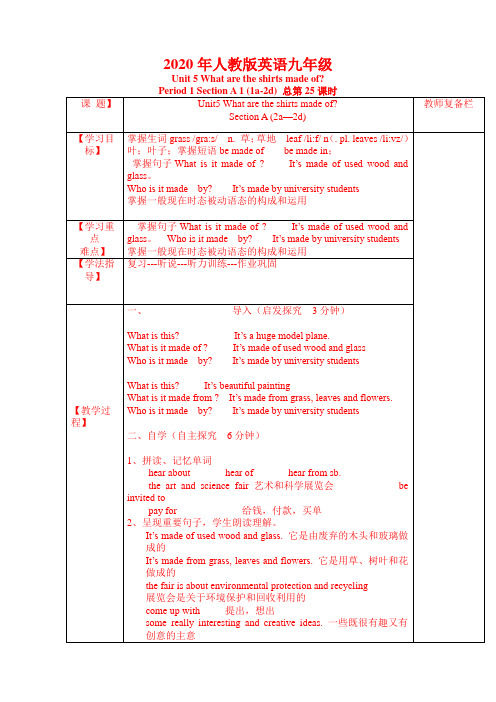
2020年人教版英语九年级Unit 5 What are the shirts made of?Period 2 Section A Section A (3a-3c) 总第26课时一、教学目标:1. 语言知识目标:1) 学习掌握下列词汇:France, no matter, local, brand, avoid, product, handbag,mobile, everyday2)阅读短文,能按要求找到相应的信息。
3)通过阅读提高学生们的阅读能力。
4) 了解“中国制造”已在世界各国广泛存在,并被世界人民所认可。
2. 情感态度价值观目标:通过阅读短文,让学生们明白中国在近代的发展状况,认识到我们伟大的中国正在快速崛起,从以前依赖进口国外工业产品,到中国制造,中国已加入工业大国之列。
二、教学重难点1. 教学重点:1) 掌握本部分出现的生词和词组,达到熟练运用的目标。
2) 阅读短文,获得相关的信息。
通过阅读练习,来提高阅读能力。
2. 教学难点:1) 阅读短文,获得相关的信息的能力。
2) 理解并运用所学的词汇及表达方式。
三、教学过程Ⅰ. Revision1. Ask Ss to role-play the conversation in 2d.2. Check the homework. Let some Ss tell read their sentences.(1). This ring is made of silver.(2). This kind of paper is made from wood.(3). What is paint made from?(4). Hang Zhou is famous for tea.(5). As far as I know, tea plants are grown on the sides of the mountains.Ⅱ. Lead in1. 展示一段伦敦奥运会礼品的视频,让学生了解中国制造已被世界人民所接受。
人教新目标英语九年级Unit5 复习学案(含答案)
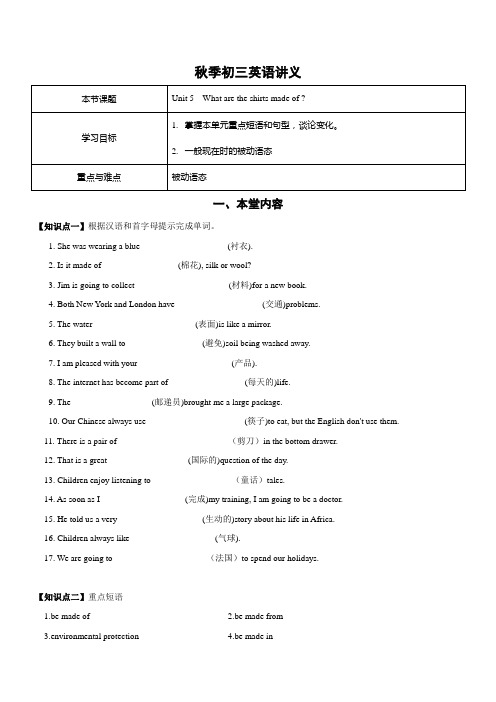
秋季初三英语讲义一、本堂内容【知识点一】根据汉语和首字母提示完成单词。
1. She was wearing a blue __________________(衬衣).2. Is it made of _________________(棉花), silk or wool?3. Jim is going to collect _____________________(材料)for a new book.4. Both New York and London have __________________(交通)problems.5. The water _______________________(表面)is like a mirror.6. They built a wall to _________________(避免)soil being washed away.7. I am pleased with your _____________________(产品).8. The internet has become part of _________________(每天的)life.9. The __________________(邮递员)brought me a large package.10. Our Chinese always use ______________________(筷子)to eat, but the English don't use them.11. There is a pair of _________________________(剪刀)in the bottom drawer.12. That is a great __________________(国际的)question of the day.13. Children enjoy listening to __________________(童话)tales.14. As soon as I ___________________(完成)my training, I am going to be a doctor.15. He told us a very ___________________(生动的)story about his life in Africa.16. Children always like ___________________(气球).17. We are going to _____________________(法国)to spend our holidays.【知识点二】重点短语1.be made of________________2.be made from_______________3.environmental protection_________4.be made in____________5.以......闻名;为人知晓 ___________6.be produced in_____________7.作为….著名_____________ 8.据我所知 _________________9.pick by hand_____________ 10..全世界________________11.不论;无论______________ 12.即使_________________13.避免做某事 _______________ 14.everyday things_________15.according to ________ 16.paper cutting___________17.such as ____________ 18.把......变成...... ________19.send out____________ 20.被......覆盖 ___________21.be seen as ____________ 22.as symbols of___________23.fairy tale _______ 24. in trouble _______【知识点三】重点句1. China is famous for tea, right?be famous for=be known for… 意为;___________。
人教版英语九年级Unit5学案
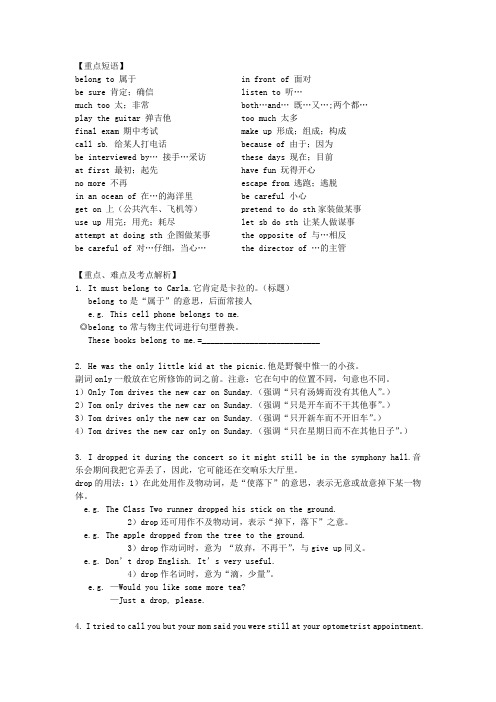
【重点短语】belong to 属于 in front of 面对be sure 肯定;确信 listen to 听…much too 太;非常 both…and…既…又…;两个都…play the guitar 弹吉他 too much 太多final exam 期中考试 make up 形成;组成;构成call sb. 给某人打电话 because of 由于;因为be interviewed by…接手…采访 these days 现在;目前at first 最初;起先 have fun 玩得开心no more 不再 escape from 逃跑;逃脱in an ocean of 在…的海洋里 be careful 小心get on 上(公共汽车、飞机等) pretend to do sth家装做某事use up 用完;用光;耗尽 let sb do sth 让某人做谋事attempt at doing sth 企图做某事 the opposite of 与…相反be careful of 对…仔细,当心… the director of …的主管【重点、难点及考点解析】1. It must belong to Carla.它肯定是卡拉的。
(标题)belong to是“属于”的意思,后面常接人e.g. This cell phone belongs to me.◎belong to常与物主代词进行句型替换。
These books belong to me.=___________________________2. He was the only little kid at the picnic.他是野餐中惟一的小孩。
副词only一般放在它所修饰的词之前。
注意:它在句中的位置不同,句意也不同。
1)Only Tom drives the new car on Sunday.(强调“只有汤姆而没有其他人”。
人教版九年级全册英语Unit5 SectionA 知识讲解+专题练习学案(含答案)

Unit5 SectionA知识讲解1. be famous for 以……闻名be famous as作为……而出名,as后接身份、职业等。
be famous to 为……所熟知2. It seems + that从句看起来……;似乎……;好像……(1)It seems like...意为"似乎……;好像……",后常接名词。
(2)seem (+ to be) + adj.(3)seem to do sth.3. be good for对……有益其反义短语be bad for,意为"对……有害"。
4. no matter无论,不论no matter how = however (无论怎样)no matter what=whatever (无论什么)no matter when=whenever (无论何时)no matter where=wherever (无论哪里)5. allow v.允许(1)allow sb. to do sth.允许某人做某事。
(2)allow doing sth. 允许做某事。
专题练习一、单项选择1.We promise ________ the environment.A.to not pollute B.not pollute C.not to pollute D.polluting 2.We ________ turn off the lights now because there are still some students. A.needn’t to B.don’t need C.don’t need to D.aren’t need 3.At last, they decided ________ to Hong Kong on vacation.A.go B.going C.goes D.to go 4.Children couldn’t wait ________ the gift box _________ the morning of Christmas Day. A.open; in B.to open; on C.open; on D.to open; in 5.The computer requires ________. I think I need ________ to ask Mr. Zhang for help. A.fixing; going B.to fix; going C.fixing; to go D.to fix; to go二、完型填空Do you like going to the movies? 6 of the students like movies very much. Last Monday I went to a middle school and 7 some students about their favorite movies. Some of the 8 were really interesting. Here are their likes and 9 : Rick , 10 eleven-year-old boy , likes watching thrillers(惊悚片)because they are scary 11 exciting . His classmate , Lisa , 12 stand documentaries . She told me they were 13 parents. But she really likes comedies because they are14 . Victor is a big boy .He said he didn’t mind documentaries. But he doesn’t like comedies because they are boring! And the coolest movies are action movies. Everyone15 them very much .6.A.Most B.Many C.Much D.Any 7.A.told B.asked C.talked D.said 8.A.names B.subjects C.answers D.questions 9.A.wants B.speaks C.takes D.dislikes 10.A.the B.an C.a D.these 11.A.but B.or C.and D.then 12.A.don’t B.isn’t C.can’t D.wasn’t 13.A.at B.with C.of D.for 14.A.boring B.sad C.unfriendly D.funny 15.A.listens B.enjoys C.waits D.thinks三、阅读单选There are five people in my family. We all like watching TV, but we like different TV shows (节目).My grandpa is a great fan(迷) of Beijing Opera(京剧). He likes watching it very much. Now he is in a Beijing Opera club(俱乐部). There he talks about Beijing Opera and acts in it with other Beijing Opera fans.My grandma likes cross talk(相声), and she often watches it on TV. Her favorite cross talker is Guo Degang.My father is a reporter(记者)from a TV station(电视台). He watches all kinds of TV shows, but his favorite TV show is news.My mother is a teacher. Her favorite TV shows are soap operas(肥皂剧). She thinks theyare very interesting. But I think they are very boring.I like playing basketball, so my favorite TV shows are sports shows. I like watching basketball games best on TV.What kind of TV shows do your family like?16._______ is the writer’s grandpa’s favorite TV show..A.talk show B.Beijing OperaC.sports shows D.soap operas17.What does the writer think of soap operas?A.Exciting B.BoringC.Interesting D.Relaxing18.The writer’s mother is ________.A.a reporter B.a housewifeC.a teacher D.a cross talker19.Which of the following is TRUE?A.The writer’s grandfather is in a Beijing Opera club.B.Guo Degang is the writer’s father’s favorite cross talker.C.The writer’s mother likes watching all kinds of TV shows.D.The writer likes watching soccer games best on TV.20.The best title(标题)of the passage may be ________.A.Popular TV showsB.Different TV showsC.My Favorite TV ShowsD.My family’s Favorite TV Shows四、用所给单词的正确形式填空21.—Do I need _______(call) Tom back? —I think so.22.As a famous dancer, she needs _______ (dance)for two hours every day. 23.Would you like ____________ (go) to the park for a jogging with me?24.I want _________ (visit) the Buckingham Palace very much, because I’m very interested in the Queen’s life.25.I like climbing and I decide _____________(be) a climber when I grow up.五、完成句子26.我想知道他们的名字。
人教版九年级上册英语第五单元学案设计 (2)

Unit 5What are the shirts made of?Period 1Section A 1a-2d【课型】听说课学习目标(1)能掌握以下单词:chopsticks,window,coin,stamp,fork,blouse,wood,gold,silver,paper,silk,cotton,glass。
能掌握被动语态的句式结构句型:A:What is the model plane made of?B:It’s made of used wood and glass.(2)能了解被动语态的用法。
学习过程【自主学习】利用生活中的实物来谈论其制作材料,体会本节课目标句型be made of/from的使用情境。
【新课导入】A:What is the T-shirt made of?B:It’s made of.【新知呈现】Newwords:chopsticks,window,coin,stamp,fork,blouse,wood,gold,silver,paper,silk,cotton,glass.Structures:A:What is the model plane made of?B:It is made of used wood and glass.Work in pairs to make similar conversations.【拓展提升】Use the things around you to talk about what they are made of and where they were made.A:What is the ring made of?B:It is made of silver.A:Where was it made?B:It was made in Thailand.【跟踪训练】完成句子1.这个杯子是用玻璃制成的。
The cup is glass.2.书籍是用纸制的。
初中英语九年级全册Unit 5(含答案解析)

一、选择题1.— Do I have to do this right now?—Yes, it _______ that you don’t have much choice (选择的权利).A.says B.looks C.seems D.thinks C解析:C【详解】句意:-我必须现在就做吗?-是的,好像你没有选择的权利。
says说;looks看;seems好像;thinks思考,认为。
这里考查固定句型It seems that…“好像…”。
故选C。
第II卷(非选择题)请点击修改第II卷的文字说明2.There _________ on the road at 5 p.m. every day.A.are a lot of traffics B.is a lot of trafficC.are a lot of traffic D.is a lot of traffics B解析:B【分析】【详解】句意:每一天下午5点路上有很多车。
考查there be句型。
traffic交通;运输;不可数名词;there be句型的be动词遵循“就近原则”,故选B。
3.The basketball match will be covered _______ on TV tonight.A.lively B.live C.living D.alive B解析:B【详解】句意:今晚电视将直播篮球赛。
考查形容词辨析。
lively生机勃勃的,活跃的;live活的;现场直播的; living活着的;alive 活着,在世。
根据“be covered ____ on TV”可知,这里是篮球比赛通过电视现场直播的。
故选B。
4.J. K. Rowling is widely known ________ her novels Harry Potter series.A.as B.of C.for D.by C解析:C【详解】句意:J·K·罗琳因为她的小说《哈利·波特》系列而出名。
2020-2021学年九年级英语全册unit5unit5导学案(新版)人教新目标版英语
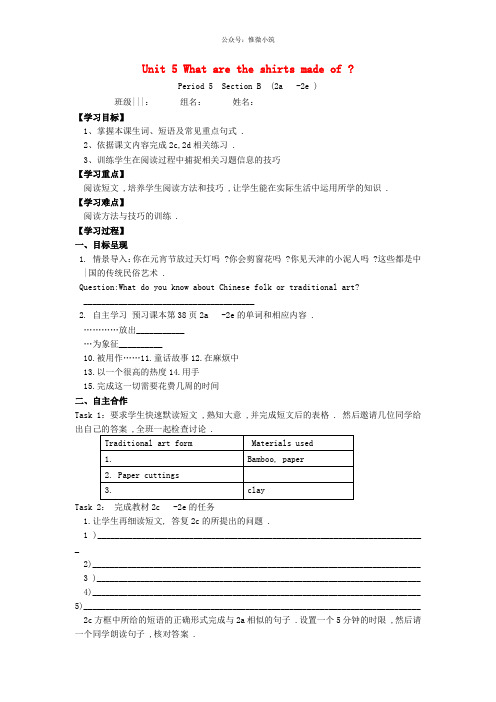
Unit 5 What are the shirts made of ?Period 5 Section B (2a -2e )班级|||:组名:姓名:【学习目标】1、掌握本课生词、短语及常见重点句式 .2、依据课文内容完成2c,2d相关练习 .3、训练学生在阅读过程中捕捉相关习题信息的技巧【学习重点】阅读短文 ,培养学生阅读方法和技巧 ,让学生能在实际生活中运用所学的知识 .【学习难点】阅读方法与技巧的训练 .【学习过程】一、目标呈现1. 情景导入:你在元宵节放过天灯吗 ?你会剪窗花吗 ?你见天津的小泥人吗 ?这些都是中|国的传统民俗艺术 .Question:What do you know about Chinese folk or traditional art?_______________________________________2. 自主学习预习课本第38页2a -2e的单词和相应内容 .…………放出___________…为象征__________10.被用作……11.童话故事12.在麻烦中13.以一个很高的热度14.用手15.完成这一切需要花费几周的时间二、自主合作Task 1:要求学生快速默读短文 ,熟知大意 ,并完成短文后的表格 . 然后邀请几位同学给Task 2:完成教材2c -2e的任务1.让学生再细读短文, 答复2c的所提出的问题 .1 )__________________________________________________________________________ _2)___________________________________________________________________________3 )__________________________________________________________________________4)___________________________________________________________________________5)_____________________________________________________________________________ 2c方框中所给的短语的正确形式完成与2a相似的句子 .设置一个5分钟的时限 ,然后请一个同学朗读句子 ,核对答案 .1)______________,________________2)_______________,_______________3)______________,________________3、再次阅读课文 ,将课文分段 .How many pats do you think the passage can be divided into?why?_______________________________________________________________________________ _______________________________________________________________________________ _______________________________________________________________________________ _______________________________________________________________________________4. 让学生分组先讨论一下2e所提出的问题 .三、展示质疑DiscussionWhat are some special things that your hometown or city is famous for? Discuss with a partner and take notes.四、稳固构建:根据汉语提示填空完成句子1.当孔明灯被点燃时 ,他们慢慢地升入空中 .When the lanterns ,they slowly the air.2.它们被视为快乐和美好愿望的象征 .They bright symbols of and good .3.纸通常是红色的 ,在被剪刀剪切之前 ,会先被折叠 .The paper ,usually red ,before it is with scissors.4.弄干后 ,在高温下烤烧它们 .After ,they are at a very high .5他认为中|国这么擅长造这些日常用品很了不起 .(good)He thinks it ,s great that _____________________these everyday things.6不管发生什么事 ,我会一直支持你 .(matter)__________________________,I will always be there for you.7地球外表的绝|||大多数局部是被水覆盖地.(cover)Most of the earth ,s surface ___________________.8似乎全世|界很多人都喝中|国菜 .It seems that many people ___________________drink Chinese tea.。
人教版九年级英语Unit5全英文教案新目标-人教新目标版九年级全册
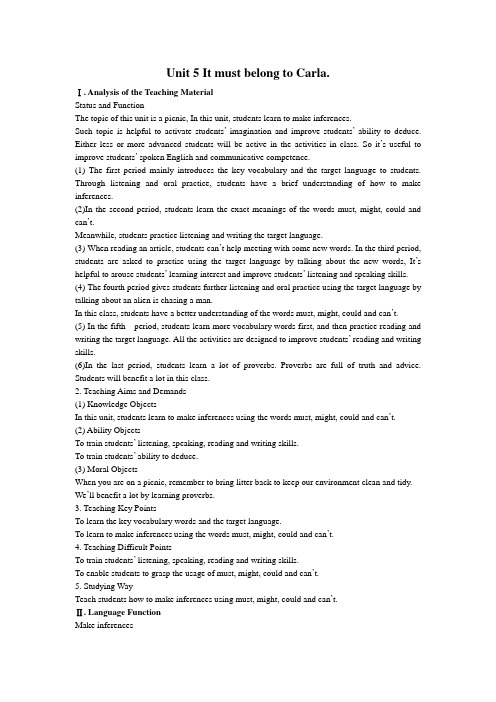
Unit 5 It must belong to Carla.Ⅰ. Analysis of the Teaching MaterialStatus and FunctionThe topic of this unit is a picnic, In this unit, students learn to make inferences.Such topic is helpful to activate students’imagination and improve students’ability to deduce. Either less or more advanced students will be active in the activities in class. So it’s useful to improve students’ spoken English and communicative competence.(1) The first period mainly introduces the key vocabulary and the target language to students. Through listening and oral practice, students have a brief understanding of how to make inferences.(2)In the second period, students learn the exact meanings of the words must, might, could and can’t.Meanwhile, students practice listening and writing the target language.(3) When reading an article, students can’t help meeting with some new words. In the third period, students are asked to practise using the target language by talking about the new words, It’s helpful to arouse students’ learning interest and improve students’ listening and speaking skills. (4) The fourth period gives students further listening and oral practice using the target language by talking about an alien is chasing a man.In this class, students have a better understanding of the words must, might, could and can’t. (5) In the fifth period, students learn more vocabulary words first, and then practice reading and writing the target language. All the activities are designed to improve students’ reading and writing skills.(6)In the last period, students learn a lot of proverbs. Proverbs are full of truth and advice. Students will benefit a lot in this class.2. Teaching Aims and Demands(1) Knowledge ObjectsIn this unit, students learn to make inferences using the words must, might, could and can’t. (2) Ability ObjectsTo train students’ listening, speaking, reading and writing skills.To train students’ ability to deduce.(3) Moral ObjectsWhen you are on a picnic, remember to bring litter back to keep our environment clean and tidy. We’ll benefit a lot by learning proverbs.3. Teaching Key PointsTo learn the key vocabulary words and the target language.To learn to make inferences using the words must, might, could and can’t.4. Teaching Difficult PointsTo train students’ listening, speaking, reading and writing skills.To enable students to grasp the usage of must, might, could and can’t.5. Studying WayTeach students how to make inferences using must, might, could and can’t.Ⅱ. Language FunctionMake inferencesⅢ. Target LanguageWhose volleyball is this?It must be Carla’s. She loves volleyball.It could be Ted’s.Ⅳ. Structuremust, might, could and can’tⅤ. Vocabularypicnic, chase, escape, belong to, toy car, plate’, mystery, appointment, worried, wake, neighbor, garbageⅥ. Recyclingsuit, land, volleyball, magazine, book, CD, bat, earring, T-shirt, UFO, whose, owner, exercise, dream, anxiousⅦ. Learning Strategies1. Sequencing2. DeducingⅧ. Teaching TimeSix periodsThe First PeriodI. Teaching Aims and Demands1. Knowledge Objects(1) Key V ocabularybelong, belong to, plate, author, toy, picnic(2)Target LanguageWhose book is this?It must be Mary’s. Wanda Wilbur is her favourite author.2. Ability Objects(1) Train students’ listening skill.(2) Train students’ communicative competence using the target language.3. Moral ObjectsWhen you are on a picnic, remember to bring litter back to keep our environment clean and tidy. Ⅱ.Teaching Key Points1. Key vocabulary2. Target languageⅢ.Teaching ProceduresStep I RevisionCheck homework. Invite different students to say the answers to the exercises on pages 12~14 of the workbook.Step Ⅱ1aThis activity introduces the key vocabulary.Write the key vocabulary words on the blackboard. Say the words one by one and have students repeat several times until they can read them fluently and accurately.Ask different students to explain in their own words the meanings of the words belong to, author and picnic.Belong means to be owned by somebody.An author is a writer of a book or a play.A picnic is a meal eaten out of doors.Then invite two students to draw a plate next to the word plate and a toy car next to toy.Focus attention on the picture. Have students point to each item and say its name. Call students attention to the chart with the headlines clothing. Funthings and kitchen things at the top. Invite different students to explain the meanings of the column heads.Say, Please look at the picture and write the things you see in the correct columns in the chart. Point out the sample answers. Get students to complete the task on their own. As they work, move around the room checking their progress and answering any questions they may have.Show the correct answers on the screen by a projector.Step ⅢlbThis activity gives students practice in understanding the target langugage in spoken conversation. Call students’ attention to the chart. Set a time limit of two minutes. Students read the persons, the things and the reasons.Say, You will hear a conversation. As you listen, draw lines to connect the person in the first column with the thing in the second column. Then draw another line to connect the thing in the second line with the reason in the third column.Point out the sample answer. Say, The name Carla in the first column connects to volleyball in the second column because that’s the thing they are talking about. And the word volleyball in the second column connects with the sentence she loves volleyball in the third column.Play the recording the first time.Students only listen. Play the recording again. This time students listen and match each person with a thing and a reason.Check the answers.Step Ⅳ1cThis activity provides oral practice using the target language.Point to the picture in Activity lb. Invite pair of students to say the conversation in the speech bubbles.Point out the conversation in the box. Invite another pair of students to say it to the class. S A : Whose book is this?S B: It must be Mary’s. Wanda Wilbur is her favourite author.Write the conversation on the blackboard.Point out the chart in Activity 1b. Say.Now work with a partner. Start by reading the conversations in the picture and in the box: Then make conversations using the information in the chart in Activity 1b. Talk about who each thing might belong to and give a reason. Get students to practice in pairs. As they work, move around the classroom listening in on various pairs and offering help with language and pronunciation as needed.After all the students have had an opportunity to ask and answer questions, stop the activity. Get different pairs of students to say their conversations to the class.Step ⅤSummarySay, In this class, we’ve learned the key vocabulary words belong to, plate, author, toy and picnic and done much listening and oral practice using the target language.Step ⅥHomework(1) Say and remember the spelling of the vocabulary words.(2)Say the conversations in Activity 1c to get a further understanding of the target language.Unit 5 It must belong to Carla.The Second PeriodI. Teaching Aims and Demands1. Knowledge Objects(1) Key V ocabularydrop, symphony, optometrist, appointment, algebra, crucial, count, because of, Chinese-English dictionary, Oxford University(2) Target LanguageWhat do you think "anxious" means?Well, it can’t mean "happy".It might mean "worried".Oh, yes, she is worried because of her test.Here are some earrings. The owner can’t be a boy.Well, it could be a boy. The earrings might be a present for his mother.2. Ability Objects(1) Train students’ reading skill.(2) Train students’ communicative competence using the target language.Moral ObjectWhen you are in trouble, send an e-mail message to your friends to ask for help.Ⅱ. Teaching Key Points1.Reading practice2.Oral practice using the target languageⅢ. Teaching Difficult Points1. Key vocabulary2. Target languageⅣ. Teaching ProceduresStep I RevisionRevise the usage of the words must, might, could and can’t by checking homework.Ask students to exchange their exercises books and help correct any errors with each other, As they are doing this, move around the classroom offering language support as needed. Then invite different students to say their sentences to the class.Step Ⅱ3aThis activity provides reading practice using the target language.Call students’attention to the picture.Ask students to tell what’s happening in the picture.T: What’s the girl doing?S s: She is using the computer to write e-mail.Point to the parts of the e-mail message.Tell students that this is the message the girl in the picture writes. Say, Right now the parts are in the wrong order. When they are in the right order, they will make a clear message. Now please read the parts carefully. Number them in order. When you are doing this, you will meet with some words you don’t know.Don’t worry too much about them. Just circle them. We’ll talk about what they mean later.Get students to complete the task on their own. Point out the sample answer.Say. The first sentence of the e-mail message is I’m really anxious, because I can’t find my backpack.Check the answers.Step Ⅲ3bThis activity provides oral practice using the target language.Read the instructions to the class. Point to the sample conversation. Invite a pair of students to say it to the class.S A: What do you think "anxious" mean? S B: Well, it can’t mean "happy".S A: It might mean "worried". S B: Oh, yes. She is worried because of her test.Write the conversation on the blackboard.Say, You are to talk about the circled words in Activity 3a. Use the words can’t, must, could or might as in the sample.Get students to work with a partner. As they work in pairs, move around the classroom helping students with pronunciation and answering any questions they may have. Some time later, stop the activity. Ask different students to share their conversations with the class. Make a list of the words students are talking about on the blackboard.Practice the pronunciation of these words and explain the meaning of each word. Step ⅣPart 4This activity provides oral practice using the target language.Call students’ attention to the picture. Get students to name each item in it.Write the new words Chinese-English dictionary and Oxford University on the blackboard. Point to the sample conversation. Invite a pair of students to read it to the class.Write the conversation on the black board. Explain the meaning of each sentence. Focus attention on the chart with the headlines Can’t, Could/might and Must at the top. Point out the sample answer.Read the instructions to the class.Get students to complete the task in pairs. As the pairs work together, move around the classroom helping students with pronunciation, sentence formation or anything else they ask for help with.Ask some pairs to say their conversations to the class.Note: Answers to the chart will vary.Step ⅤSummarySay, In this class, we’ve learned some vocabulary words, such as drop, symphony.And we’ve done much oral practice using the target language.Step ⅥHomework1. Read the letter in Activity 3a again for further understanding of the vocabularywords.2. Read the conversations in Activities 3b and 4 again for further understanding of the target language.3. Finish off the exercises on pages 15~16 of the workbook.The Third PeriodI. Teaching Aims and Demands1. Knowledge Objects(1) Key Vocabulary:chase, creature(2) Target LanguageWhy do you think the man is running?He could be running for exercise.No, he’s wearing a suit. He might be running to catch a bus.2. Ability Objects(1)Train students’ listening skill.(2)Train students’ writing skill.3. Moral ObjectThe UFO and alien are both unreal. As students, we must work hard to explore the universe in the future.Ⅱ. Teaching Key Points1. Listening practice2. Writing practiceⅢ. Teaching Difficult Points1. Write a sentence about each picture.2. Write two or three sentences to finish the story.3. Listen and complete the sentences.Ⅳ. Teaching ProceduresStep ⅠRevision1. Invite a student to read the thank you message Linda wrote to Anna to the class.2. Get different pairs of students to read the conversations in Activities 3band 4.3. Check answers to the exercises on pages 15~16 of the workbook.StepⅡPart lThis activity provides writing practice using the target language.Read the instructions to the class. Read the words in the box and have students repeat several times. Invite different students to explain the meaning of each word in their own words.Get students to look at the three pictures carefully. Say, You are to use the words from the box to write a sentence about each picture. Point out where to write the sentences. Ask a student to say the sample answer to the class. Get students to complete the activity individually. As students work, walk around the classroom offering language support as needed.Check the answers on the blackboard.Step Ⅲ2aThis activity gives students practice understanding and writing the target language in spoken conversation.Read the instructions to the class. Point to the three pictures in Activity 1. Say, You will hear a conversation about these pictures. As you listen, write a number in the box in the left corner of each picture to show the order of the events.Point out the sample answer in the box of the third picture. Say, You will hear the man is running first. Play the recording the first time. Students only listen. Play the recording again. This time students listen and number the pictures. Encourage students to write two or three sentences to finish the story.Answers will vary. Write a sample version on the blackboard. Ask students to use it as a model.Step Ⅳ2bThis activity gives students practice listening to and writing the target language.Point to the chart with sentence startersThey see …The man says…and The woman says…Say, You are to listento the same recording again. And complete each sentence.Point out the sample answers. Say, They see a man running. The man says he could be running for exercise. The woman says he might be late for work. Explain the meaning of the word creature to the students.Play the recording once or twice, using the Pause button as necessary.Show the answers on the screen by a projector so thatStep Ⅴ2cThis activity provides oral practice using the target languagePoint out the sample conversation in the box. Invite a pair of students to read it to the class.S A: Why do you think the man is running?S B: He could be running for exercise.S A: No, he’s wearing a suit. He might be running to catch a bus.Write it on the blackboard.Say, Now work with a partner. Start by reading the conversation in the box with your partner. Then role play conversations using information in Activity 2b.Get students to work in pairs. As the pairs work together, walk around the classroom listening in on various pairs and offering help needed. Ask several pairs to say their conversations to the class.Step ⅥSummarySay, In this class, we’ve mainly done much listening and writing practice using the target language.Step ⅦHomeworkAsk students to collect pictures of different kinds and then talk about them using must, could, might and can’t.The Fourth PeriodI. Teaching Aims and Demands1. Knowledge Objects(1) Key Vocabularyextremely, worried, neighbor, garbage, mystery, director, escape, ocean(2) Target LanguageIn my dream, I was swimming in an ocean of paper.Maybe it means you’re afraid of too much homework!2. Ability Objects(1) Train students’ reading skill. (2) Train students’ writing skill.(3) Train students’ integrating skills.3. Moral ObjectEveryone has had a dream. But don’t dream away your time.Ⅱ. Teaching Key Points1. Key vocabulary2. Reading practice3. Writing practiceⅢ. Teaching Difficult Points1. Reading practice2. Writing practiceⅣ. Teaching ProceduresStep ⅠRevisionCheck homework.Collect pictures from students on the teacher’s desk. Hold up one at a time and ask students to describe it using the target language introduced in the preceding classes. For example:T: (Holding up a picture with a boy swimming in an ocean of books) What do you think is happening to the person in the picture?S1: He must be a student. S2: He could be having a dream. S3: He might like reading books. Step Ⅱ3aThis activity provides reading practice using the target language.Show the key vocabulary words on page 38 on the screen by a projector.Say the words one by one and have students repeat several times until they can pronounce them fluently and accurately. Read the title of the newspaper article strange events in Bell Tower neighborhood to the class. And then point to the picture and ask students. How is the person feeling? Help students to answer. He is confused and upset.Call students’ attention to the article. Read it to the class. Say, Now please read the article individually and underline what people think could be causing the strange things that are happening in Bell Tower. Point out the sample answer.Get students to complete the task individually. As they work, walk around the classroom answering any questions they may have and offering help as needed. Check the answers.Answersan animal, teenagers, the wind, a dogStep Ⅲ3bThis activity provides reading and writing practice using the target language.Get students to discuss any words or sentences they don’t know in Activity 3a with one another. Call students’attention to the three sets of notes. Ask different students to read them to the class.Chu family--late night footsteps in the hallway--might be the neighborsLao Zheng--someone trying to get in the window--might be the windXiao Ning--finds garbage in front of her house--might be catsSay, You are to write another paragraph about Bell Town using these notes. You may use the article inActivity 3a as a model. Ask students to write their paragraphs on their own in the exercise books. As they work, move around the classroom offering language support as needed. Get a few students to read their works to the class. Answers will vary. Write the sample version on the blackboard.Step Ⅳ3cThis activity provides writing practice using the target language.Read the title No more mystery in Bell Tower neighborhood to the class and explain the meaning of the word mystery. Invite a student to read the opening sentences to the class. Divide the class in to groups of four to discuss what should be included in the article.Two or three minutes later, stop the activity. Say, Now please finish the article about the strange events in Bell Tower. Use the ideas you discussed along with original ideas of your own to complete the article. Get students to complete the task on their own in the exercise books. As they are writing, move around the classroom offering help as needed. Ask some students to read their articles to the class.Collect students’ works and write a comment on each paper before returning them.Step ⅤPart 4This activity provides reading, writing, listening and speaking practice using the target language. Read the instructions to the class. Point to the picture. Ask students to tell what is happening in it. Invite a pair of students to read the sample conversation in the box to the class.Say, Once I had a dream. In my dream, I was eating a state dinner. What might the dream mean? Students may answer.Maybe it means you are too hungry. Say. Think of a dream you had recently and tell your classmates about it Your classmates guess what the dream might mean. Please work with a partner. Start practice by reading the sample conversation. As the pairs work together, walk around the room offering help with pronunciation and language. Ask different pairs to tell the class about their dream and what they may mean.Step ⅥSummarySay, In this class, we’ve mainly done much reading and writing practice using the target language. We’ve learned some vocabulary words as well.Step ⅦHomework1. Reread the newspaper article in Activity 3a.2. Review the paragraph in Activity 3b,The Fifth PeriodI. Teaching Aims and Demands1. Knowledge Objects(1)Key Vocabularyfinger, stone, ant, poor, dishonest, bark, wake, pretend, use up, attempt(2)Fill in blanks and make sentences using vocabulary words.(3)Learn some proverbs.(4)Circle the word that doesn’t belong.2. Ability Objects(1)Train students’ writing skill.(2)Train students’ ability of reading comprehension.(3)Train students’ ability of clarifying.3. Moral ObjectWe’ll benefit a lot by learning proverbs.Ⅱ. Teaching Key Points1. Make sentences using vocabulary words.2. Say the meanings of different proverbs in your own words.3. Circle the word that doesn’t belong.Ⅲ. Teaching Difficult Points1. Make sentences using vocabulary words.2. Say the meanings of different proverbs in your own words.Ⅳ.Teaching ProceduresStep ⅠRevisionAsk several students to read the newspaper article in Activity 3a to the class.Step ⅡPart 1This activity provides a comprehensive review of vocabulary presented in the unit.of the word, for example adjusting for tense or subject/verb agreement.Ask students to fill in the blanks on their Own.Check the answers. Five students each read a sentence, filling in the blanks. The rest of the students check their answers.Answers1. favourite2. careful3. anxious4. worried5. strangeAsk students to make their own sentences with the words, preferably sentences that are meaningful. Move around the room. Collect a few students’answers with mistakes on the blackboard.Help correct the mistakes.Sample answers1. What’s your favourite song?2. Be careful while crossing a road.3. We are anxious for his safety.4. You don’t have to be worried about me.5. I had a strange dream last night.Step ⅢPart 2This activity provides reading, writing, listening and speaking practice using the target language. Show the vocabulary words on the screen by a projector.Say the words and have students repeat them until they can pronounce them fluently and accurately. Read the instructions to the class. Explain to the students that a proverb is a short well-known saying that states a general truth or gives advice.Read the first proverb to the class. One finger cannot lift a small stone. Elicit the interpretation from the students(It’s better to have help to do even small jobs).Say, Please read the proverbs, Discuss with your classmates what they might mean.Get students to work in groups of four.As the groups work together, walk around the room to make sure that students are discussing the topic in English. Invite different students to say what they think each proverb means.There can be more than one interpretation for each proverb. Check the answers by showing the sample answers on the screen by a projector.Step ⅥPart 3This activity focuses on the new vocabulary introduced in this unit.Ask students to read the five lines of words in the box.Point out the first line. In this line, escape, chase and run are all verbs. However, the word owner is a noun. So we circle it. Now please circle the word that doesn’t belong in each line.Get students to complete the task on their own. As they are doing this, move aroundthe classroom checking their progress and offering help as needed.Check the answers by asking a student to read his or her circled words to the class. Answers :1. owner 2. alien 3. land 4. exercise 5. lostStep ⅤJust for Fun!This activity provides reading and speaking practice with the target language.Ask all the students to read the cartoon story. Ask students why it is funny. Help students to answer. The boys think they are going to land on an island. Instead, they have landed on the back of a whale.Step ⅥSummarySay. In this class, we’ve practiced filling in blanks and making sentences with some vocabulary words introduced in this unit. And we’ve learned several proverbs.StepⅦHomework(1) Read and remember the proverbs learned in Activity 2.(2) Each student collects ten proverbs.(3) Finish off the exercises on pages 16~17,of the workbook.Step Ⅷ。
人教版九年级英语Unit 5习题及答案
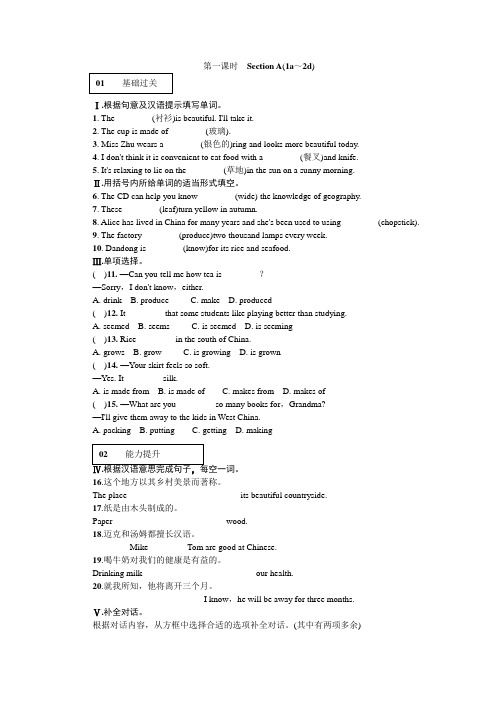
第一课时Section A(1a~2d)Ⅰ.根据句意及汉语提示填写单词。
1. The ________(衬衫)is beautiful. I'll take it.2. The cup is made of ________(玻璃).3. Miss Zhu wears a ________(银色的)ring and looks more beautiful today.4. I don't think it is convenient to eat food with a ________(餐叉)and knife.5. It's relaxing to lie on the ________(草地)in the sun on a sunny morning.Ⅱ.用括号内所给单词的适当形式填空。
6. The CD can help you know ________(wide) the knowledge of geography.7. These ________(leaf)turn yellow in autumn.8. Alice has lived in China for many years and she's been used to using ________(chopstick).9. The factory ________(produce)two thousand lamps every week.10. Dandong is ________(know)for its rice and seafood.Ⅲ.单项选择。
( )11. —Can you tell me how tea is ________?—Sorry,I don't know,either.A. drinkB. produceC. makeD. produced( )12. It ________ that some students like playing better than studying.A. seemedB. seemsC. is seemedD. is seeming( )13. Rice ________ in the south of China.A. growsB. growC. is growingD. is grown( )14. —Your skirt feels so soft.—Yes. It ________ silk.A. is made fromB. is made ofC. makes fromD. makes of( )15. —What are you ________ so many books for,Grandma?—I'll give them away to the kids in West China.A. packingB. puttingC. gettingD. making16.这个地方以其乡村美景而著称。
2019-2020年九年级英语unit5学案人教新目标版
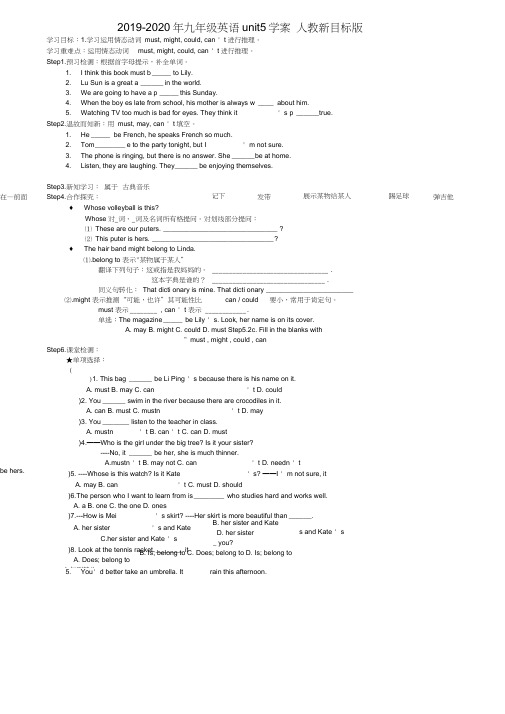
2019-2020年九年级英语unit5学案 人教新目标版 学习目标:1.学习运用情态动词 must, might, could, can ' t 进行推理。
学习重难点:运用情态动词 must, might, could, can ' t 进行推理。
Step1.预习检测:根据首字母提示,补全单词。
1. I think this book must b _____ to Lily. 2. Lu Sun is a great a ______ in the world. 3. We are going to have a p _____ this Sunday. 4. When the boy es late from school, his mother is always w ____ about him. 5. Watching TV too much is bad for eyes. They think it ' s p ______true. Step2.温故而知新:用 must, may, can ' t 填空。
1. He _____ be French, he speaks French so much. 2. Tom ________ e to the party tonight, but I ' m not sure. 3. The phone is ringing, but there is no answer. She ______ b e at home. 4. Listen, they are laughing. They ______ be enjoying themselves. 5. You ' d better take an umbrella. It rain this afternoon. Step3.新知学习: 属于 古典音乐 Step4.合作探究: ♦ Whose volleyball is this? Whose 对_词、_词及名词所有格提问。
2020九年级英语全册 Unit 5 What are the shirts made of(8)导学案人教新目标版
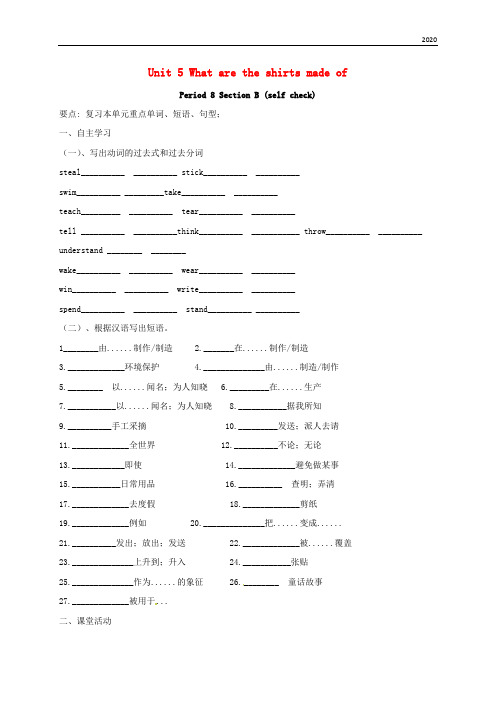
Unit 5 What are the shirts made ofPeriod 8 Section B (self check)要点: 复习本单元重点单词、短语、句型;一、自主学习(一)、写出动词的过去式和过去分词steal__________ __________ stick__________ __________swim__________ _________take__________ __________teach_________ __________ tear__________ __________tell __________ __________think__________ ___________ throw__________ __________ understand ________ ________wake__________ __________ wear__________ __________win__________ __________ write__________ __________spend__________ __________ stand__________ __________(二)、根据汉语写出短语。
1________由......制作/制造 2._______在......制作/制造3._____________环境保护4.______________由......制造/制作5.________ 以......闻名;为人知晓6._________在......生产7.___________以......闻名;为人知晓 8.___________据我所知9.__________手工采摘 10._________发送;派人去请11._____________全世界 12.__________不论;无论13.____________即使 14._____________避免做某事15.___________日常用品 16.__________ 查明;弄清17._____________去度假 18._____________剪纸19._____________例如 20.______________把......变成......21.__________发出;放出;发送 22._____________被......覆盖23.______________上升到;升入 24.___________张贴25.______________作为......的象征 26.________ 童话故事27._____________被用于...二、课堂活动1、完成教材self check 1部分的任务。
2020年人教版英语九年级Unit5全单元导学案

2020年人教版英语九年级U n i t5全单元导学案(无答案)(总14页)--本页仅作为文档封面,使用时请直接删除即可----内页可以根据需求调整合适字体及大小--Unit 5 What are the shirts made of?Period 1 Section A 1a-1c一、目标导航:1. 能掌握以下单词:chopsticks, coin, fork, blouse, silver, glass, cotton, steel, 2.能掌握以下句型:—This ring looks nice. Is it made of silver—Yes, and it was made in Thailand.3.初步理解被动语态的用法。
二、自主学习:Task 1.自读33页的单词。
Task 2.完成1a,(这些东西通常由什么制成的?把他们和原材料搭配起来,有的可能不止一个答案。
)Task 3听录音,完成课本上1b的听力任务。
Task 4两人一组先练习1a中的对话,再模仿1c的对话,用1b表格中的信息进行对话练习。
Task 5在书中划出重点、疑点后,翻译下列短语及句子。
先独立完成,后小组商议1.由……制成的___________ /____________2.在…….制造的3.由……制造的4我认为它相当漂亮,它是由银制成的吗?5.你认为这枚戒指好看吗6.它是在泰国制造的。
知识解析made from“由……制成的”,指从成品中看不出原材料纸是由木头制成的。
Paper wood.be made of “由……制成的”,指从成品中可以看出原材料桥是石头造的。
The bridge stone.be made in“在…….制造的”,in后常接表示地点的名词。
这台电脑是在美国制造的。
The computer America.be made by “由……制造的”,by 用来强调动作的执行者。
这台电视机是由这个工厂的工人生产的。
九年级英语全册 Unit 5 What are the shirts made of(第5课时)习题(含答案)
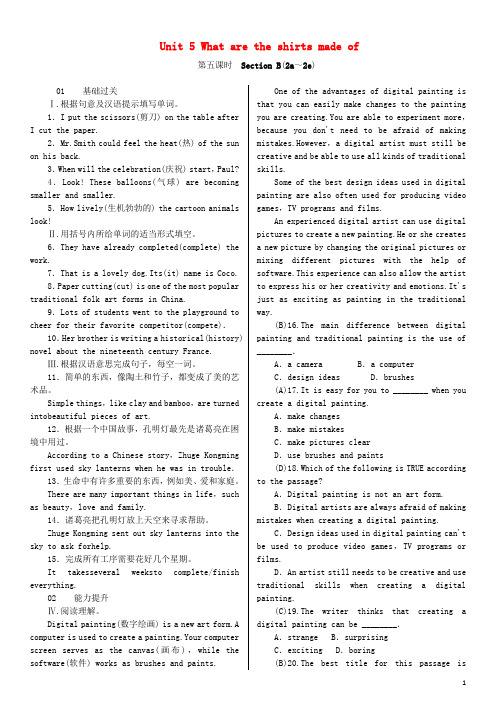
Unit 5 What are the shirts made of 第五课时Section B(2a~2e)01 基础过关Ⅰ.根据句意及汉语提示填写单词。
1.I put the scissors(剪刀) on the table after I cut the paper.2.Mr.Smith could feel the heat(热) of the sun on his back.3.When will the celebration(庆祝) start,Paul?4.Look! These balloons(气球) are becoming smaller and smaller.5.How lively(生机勃勃的) the cartoon animals look!Ⅱ.用括号内所给单词的适当形式填空。
6.They have already completed(complete) the work.7.That is a lovely dog.Its(it) name is Coco.8.Paper cutting(cut) is one of the most popular traditional folk art forms in China.9.Lots of students went to the playground to cheer for their favorite competitor(compete).10.Her brother is writing a historical(history) novel about the nineteenth century France.Ⅲ.根据汉语意思完成句子,每空一词。
11.简单的东西,像陶土和竹子,都变成了美的艺术品。
Simple things,like clay and bamboo,are turned intobeautiful pieces of art.12.根据一个中国故事,孔明灯最先是诸葛亮在困境中用过。
2020年人教版英语九年级unit5全单元导学案设计(无答案)
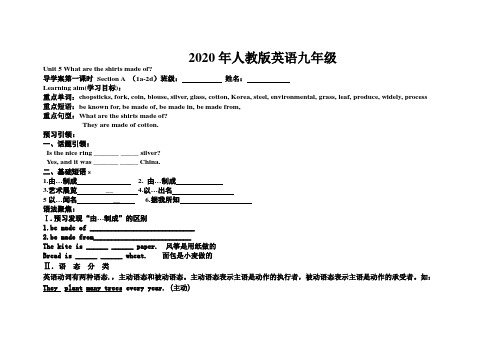
2020年人教版英语九年级Unit 5 What are the shirts made of?They are made of cotton.预习引领:一、话题引领:Is the nice ring _______ _____ silver?Yes, and it was _______ _____ China.二、基础短语s1.由…制成2. 由…制成3.艺术展览__4.以…出名5以…闻名__ 6.据我所知语法聚焦:Ⅰ.预习发现“由…制成”的区别1.be made of _____________________________2.be made from___________________________The kite is ______ ______ paper. 风筝是用纸做的Bread is ______ ______ wheat. 面包是小麦做的Ⅱ.语态分类英语动词有两种语态.,主动语态和被动语态。
主动语态表示主语是动作的执行者,被动语态表示主语是动作的承受者。
如:They plant many trees every year. (主动)Many trees are planted by them every year.(被动)汉语中常用“被”、“给”、“由”、“受”等词用来表示被动,而英语用:助动词be + 及物动词的过去分词构成。
一般现在时的被动语态的构成::am / is / are + done例如:(1)People grow rice in the south of the country.Rice_____ ______ in the south of the country.学习引领Task 1.Finish 1a, match the things with the materials.Task2Practice the conversation using the information in 1a.巩固落实First, ___________________________.Then _____________________________After that,___________________________.At last,_______________________________.1. Paper is made ___ woods.A.by B.from C.of D.in2 .Betty is often seen________ the old man with his housework.A helpB to helpC helpedD helping3. Wood can be used for______ paper.A. makingB. to makeC. madeD. make4.— Do you often clean your classroom?— Yes. Our classroom _______ every day.A. cleanB. cleansC. is cleanedD. is cleaning改写句子1. The kite is made of wood and paper.______ ______ the kite made of?1.Hangzhou is well-known for the West Lake.(改同义句)Hangzhou _______ ______ ______ the West Lake.2.People produce cotton in Xinjiang. (改同义句)Cotton _____ _______ in Xinjiang.3.这种纸是竹子做的。
- 1、下载文档前请自行甄别文档内容的完整性,平台不提供额外的编辑、内容补充、找答案等附加服务。
- 2、"仅部分预览"的文档,不可在线预览部分如存在完整性等问题,可反馈申请退款(可完整预览的文档不适用该条件!)。
- 3、如文档侵犯您的权益,请联系客服反馈,我们会尽快为您处理(人工客服工作时间:9:00-18:30)。
Unit5 What are the shirts made of?Section A 1a-2dLearning aims:1.理解、掌握和运用与日常生活相关的生词和短语。
2.学习被动语态的肯定句、一般疑问句和否定句Important and difficult points:1.被动语态的肯定句、一般疑问句和否定句2.be made of/ be made from/ be made in一、重点词汇1.筷子_________2. 硬币__________3. 餐叉__________4.银,银色的________5. 玻璃_______6. 钢________7.叶子________ __________(pl.) 8. 广泛地__________9.由…制成_____________/ _____________________10.因……而出名__________________/_________________11.全世界____________________/_________________12.as far as I know __________ 14.the art and science fair_______二、重点句型1.这枚戒指是银制的。
The ring _____ _______ ______ silver.2.它是泰国制造的。
It _____ ______ ______ Thailand.3.这幅画是由什么制作的?What_____ the painting ______ ______?4.杭州因西湖而闻名。
Hangzhou _____ _____ _____ the West Lake.三、精选试题1.This ring is made of s_______.2.The desk is made of w_______.3.Tea is p_______ in many different areas.4.Anxi and Hangzhou are w_____ known for their tea.5.When the leaves are ready, they are p_____ by hand.( )6.The Olympic Games ______ every four years.A are holdingB are heldC were held( )ually computers ____ to search the Internet.A useB are usingC are used( )8.Hangzhou is famous ____ tea.A asB forC in( )9.Today Chinese is becoming more and more popular. It ____ in many schools around the world.A is taughtB is teachingC teaches10.This book was written by Mo Yan.(改为否定句)This book _____ _______ by Mo Yan.11.The classroom is cleaned by students every day.(一般疑问句)___________________________________________________12.The boy is taken care of by the old woman.(变为主动句)____________________________________________________13.The sweater is made of wool. ( 对划线部分提问)________________________________________精选试题答案:1.Silver2. wood3.planted4. widely5.picked6-9 B C B A 10. wasn’t written11. Is the classroom cleaned by students every day?12.The old woman takes care of the boy.13. What is the sweater made of?Unit 5 What are the shirts made of?Section A 3a-3bLearning Aims1.能够阅读并且理解关于中美文化对比的短文;2.能在短文中找到并运用关于被动语态的语言结构;3.能够理解并且掌握指示代词的指代关系。
Important and Difficult Points用被动语态描述物产及其产地。
一、重点词汇1.German(复数)___________2. postman(复数)______________3. 法国______ 法语_______4.德国_______ 德国人_______5. 避免做某事__________6. search for=_______________7. 无论什么_________;___________8.尽管,虽然______________9. 美国品牌______________ 10. 一位17岁的学生____________二、重要句型1.这架飞机模型是由木头和玻璃制成的。
The _______ ________ is _____ ______wood and glass.2.虽然大多数玩具是美国牌子,但它们是在中国制造的。
_______ _______most of the toys were American brands, they ______ _______ ______China.3.美国人几乎不能够避免买中国产的商品。
Americans can _____ _____ _____ products made in China.4.我原以为这个工作很难,事实上它很容易。
I thought the work was difficult._____ ______, it was very easy.三、精选试题1.More and more tea plants _______(grow) in our hometown.2. In order to avoid_______(waste) resources, we must recycle them as much as possible.3. Many ______(product) in the local shops were made in China.4. School is a _____(日常的) event for most children.5. You can hardly avoid _____ (meet) her if you both work in the same office.6._____ ______(无论) who you are, you must obey the rules.7. Most of these _______ (produce) are made in foreign countries.8.After a long talk with his teacher, Billy got better at _____ (learn) English.( )9. He always wears his ________ clothes, it makes everyone think he doesn’t have much money.A. beautifulB. newC. everyday( )10. Many trees and flowers ________ in our city every year.A. plantedB.are plantedC. were planted( )11.—Your shirt looks nice. What is it made _________?— Silk,and it is made _____ Shanghai.A.in;ofB. of, inC. of ;from( )12. The traffic is terribly busy in the morning.You’d better avoid ______ in the center of the city.A. driveB. drivingC. to drive精选试题答案:1.are grown2. wasting3.products4. everyday/ daily5. meeting6.No matter7. products8. learning 9-12 C B B BUnit 5 What are the shirts made of?Section A Grammar focus -Section B 1a-1eLearning aims:At the end of the class, students can1.Read and use the key words: Germany, material, traffic, postman, international,competitor, cap, surface2.Understand and use the passive voice with am, is, areImportant and difficult points:Understand and use the passive voice: “be+ Vp.p”一、重点词汇1.Germany _______--_________(德国人)--__________(pl.)2. postman_______3.traffic accidents ____________4.international ______---________(国家)petitor________---___________(竞赛n.)--____________(竞赛v.)6.the surface of _____________7. be made in _____________8.many different kinds of kites __________ 9. 放风筝______________10.国际风筝节________________________ 11.find out ___________二、重点句型1.飞机模型是由什么制成的?What’s the model plane _______ _______?2.茶树被种在山的两边。
